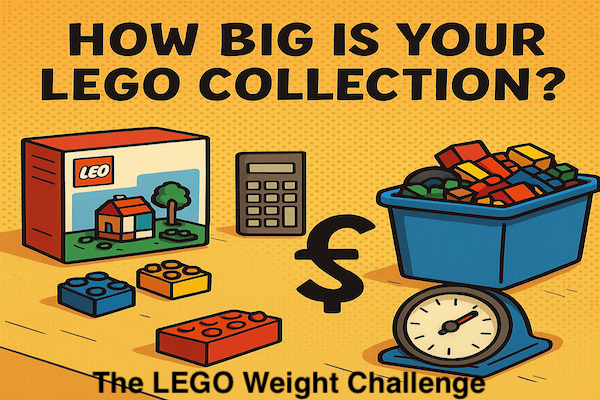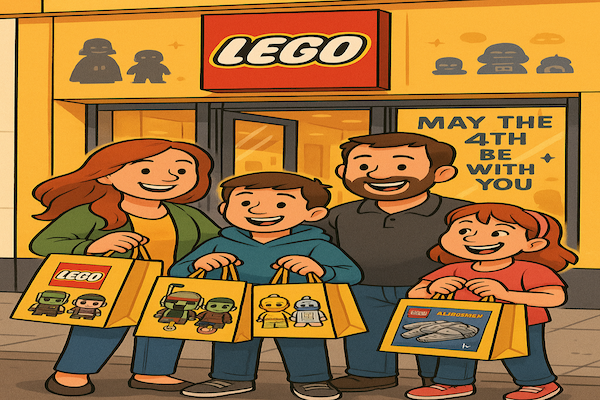
If you’ve ever found yourself staring at a wall of LEGO boxes, overflowing tubs of bricks, or carefully displayed modulars and wondered “Just how big is this collection?”, you’re not alone. LEGO Collectors love to measure, compare, and sometimes justify the size of the growing stash. But what’s the best way to actually measure a LEGO collection?
Traditionally, collectors lean on a few common methods:
1. By Set Count
Probably the simplest and most popular method. You count how many official LEGO sets you own, whether they’re built, boxed, or somewhere in between. Brickset, Rebrickable, and similar tools make this easy, especially if you track your collection online.
- Virtues: Neat and tidy, good for comparing with other collectors.
- Drawbacks: Doesn’t account for partial sets, MOCs (My Own Creations), or bulk hauls where boxes and manuals are missing.
2. By Piece Count
Another approach is adding up the number of individual bricks you own. LEGO helpfully lists piece counts for each set, so you can get a rough total. Some collectors go even deeper by cataloging loose pieces or bulk bricks by color and type.
- Virtues: Gives a sense of the scale of your building potential. Great for bragging rights when you’re in the hundreds of thousands.
- Drawbacks: Time-consuming, especially for bulk buys. Unless you only collect sealed sets, it’s very easy to lose track.
3. By Value
Some collectors prefer to measure by the financial side: the RRP (Recommended Retail Price) of their sets, the second-hand market value, or even insurance valuations.
- Virtues: Essential for protecting your collection. Also gives you a reality check on just how much “plastic gold” you’ve accumulated.
- Drawbacks: Value fluctuates, and it’s not always about money, sometimes your favourite €20 set is more valuable to you than a €500 UCS build.
4. By Display Space
A more practical way: measure how much room your LEGO takes up. How many shelves? How many cabinets? How many baseplates wide is your LEGO City?
- Virtues: Tangible, and easy to explain to non-collectors (or your partner when they ask why the dining room table is permanently occupied).
- Drawbacks: Not all LEGO is on display, and storage boxes can be deceptive.
The Newly Proposed Method: By Weight
A friend of mine recently told us on LinkedIn of their way to measure – weighing your LEGO collection.
It sounds odd at first, but it makes sense. Every piece of LEGO has mass, and if you pile your loose bricks or entire sets onto a scale, you get an unarguable number.
- Virtues:
- Simple and universal, a kilo of LEGO is a kilo of LEGO, whether it’s Friends, Technic, or Star Wars UCS.
- Great for bulk hauls where set counts and instructions don’t exist.
- Easier to compare “like for like” across collections.
- Drawbacks:
- Built sets and displayed collections are not exactly scale-friendly (you might have to dismantle them first, or balance them precariously).
- Bricks aren’t uniform in weight, a kilo of Technic beams looks very different to a kilo of 1×1 round plates.
- It doesn’t capture rarity, minifigure value, or the emotional significance of certain builds.
Still, it’s a fascinating idea, especially for a collector like me who often buy bulk hauls with no easy way to count sets or pieces. “That was a 25kg pickup” suddenly gives a much clearer sense of scale.
The LEGO Weight Challenge
To put this new method to the test, I’ve decided to take on what I’m calling the LEGO Weight Challenge. By next week, I plan to have the entire Redmond’s Forge collection weighed, sets, displays, MOCS, tubs, boxes, bulk bricks, the lot. And here’s where it gets fun: I want you to get involved. Drop your best guess in the comments below, how many kilos of LEGO do you think we’ve got here at Redmond’s Forge? I’ll reveal the answer in a follow-up post, and the closest guess wins bragging rights in the community.
I really do want to know the weight of the Star Wars Diorama MOC Meteor Crater (aka the Part Tree). When I collected it – I estimated 400kgs. My next door neighbour thought closer to 100kg. I’ll be able to answer that query also.
Which Way Works Best?
Ultimately, the best measurement method depends on what matters to you.
- If you’re a set purist: count sets.
- If you’re a builder: count pieces.
- If you’re thinking financially: track value.
- If you’re space-conscious: measure display footprint.
- If you love simplicity (or bulk buys): weigh it.
No one system is perfect, and maybe the fun lies in trying them all.
I’d love to hear from you, how do you measure your LEGO collection?
- Do you prefer to count sets, pieces, or go by weight?
- Have you ever weighed your LEGO? If so, what was the number?
- Do you measure your collection by display space, and if so, how much of your home has LEGO taken over?
- Which method feels the most honest to you as a collector?
Drop your answers in the comments below and let’s compare collections not just in size, but in creativity of measurement.

